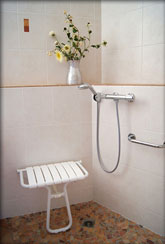Disabled Shower Safety is Vital
Injury, illness, and other factors create mobility issues that can lead to falls or accidents. According to the Centers for Disease Control, up to 80% of all falls in the home are in the bathroom. Sadly, accidents are even more common in the bathroom area for disabled or injured persons. To minimize the risk of injury, follow these 3 simple steps to improve disabled shower safety.
#1. Install Hand Rails in Shower
Hand rails make disabled showers much safer by providing critical support. For people in wheelchairs or extremely limited mobility, hand rails help make the transition to a shower chair or bench. However, poorly installed hand rails actually create safety hazards. Professional installation ensures that the rails are attached not only to the shower fixture itself, but the actual wall studs themselves. Also, try to install rails on a wall adjacent to the disabled shower area as well.
#2. Install Shower Bench or Chair
Installing a bench or chair greatly improves safety in a disabled shower. A bench or shower chair provides an area for the person to sit and bathe without standing. For disabled persons with extreme mobility issues, the placement of the rails and shower bench or chair are critical. When installed and placed properly, transitioning from a wheelchair to the shower chair is both safe and easy.
#3. Install Extended Hand Held Shower Sprays

Extended hand held shower sprays help the disabled avoid standing while bathing. Without the extended sprays, using the shower bench is virtually impossible. Placement and installation of the hand held spray is vital to ensure it can be used properly. Professional installation is strongly recommended to avoid leaks and ensure proper placement.
Additional Tips and Suggestions
Installing non-slip flooring or mats are great ideas for disabled shower safety. For the shower itself, installing non-slip flooring is best. Also, install inexpensive non-slip mats just outside the tub or shower.
Lastly, adding a tension pole is an alternative to grab bars or rails. Installing tension poles is sometimes the best alternative in bathrooms with walk-in showers.
Concluding Thoughts on Disabled Shower Safety
Sadly, even healthy people injure themselves getting in and out of the shower. For the injured or disabled, safely using the shower is even more difficult. Installing simple safety features can, and will, dramatically reduce the risk of injury. However, improper installation or placement of safety features renders all efforts moot.
Accessable Bathrooms is Perth’s exclusive disabled bath renovation specialists. We offer a free, no-obligation audit and 3D design to show you exactly how your new bathroom will look when complete!
